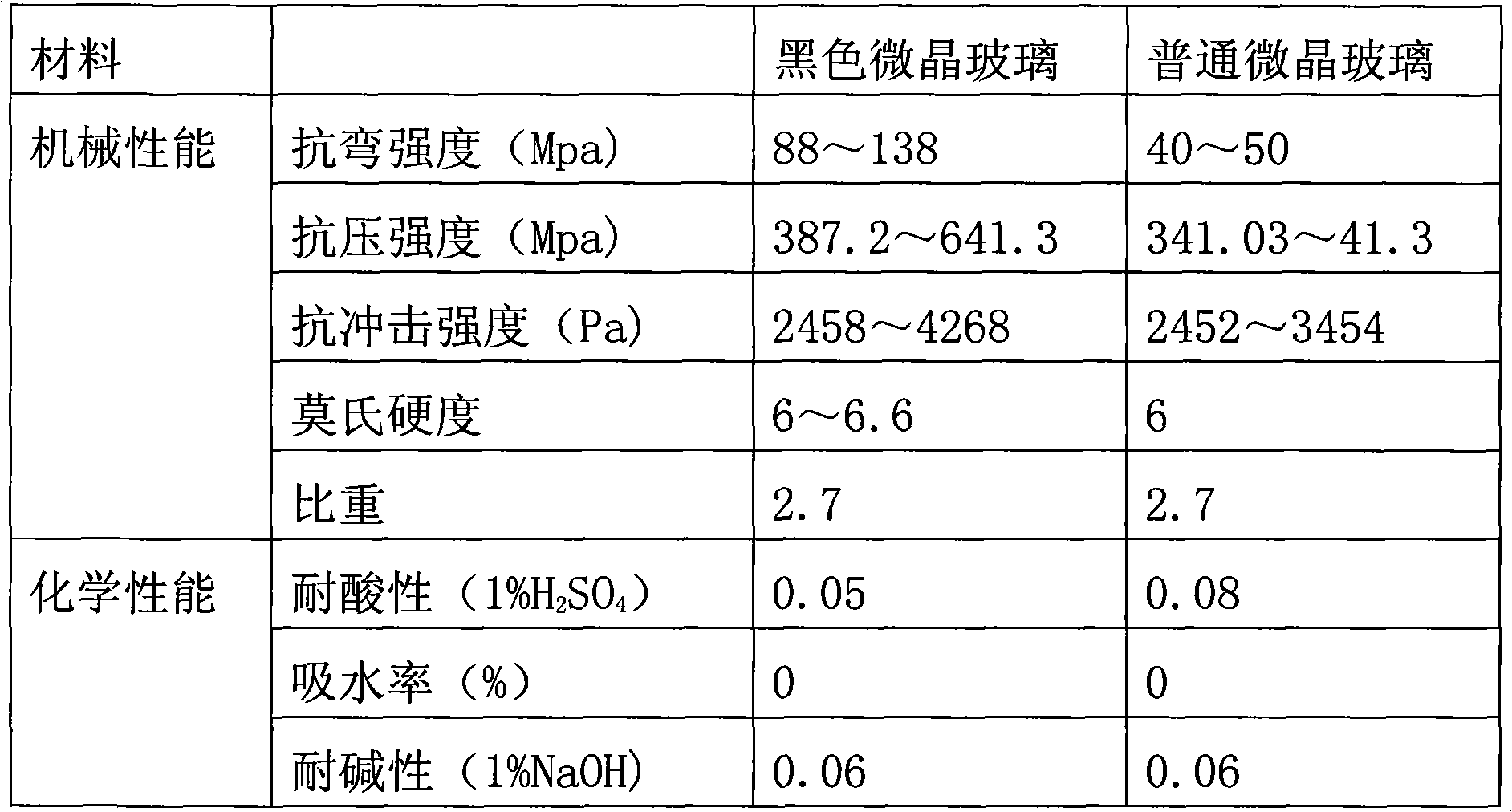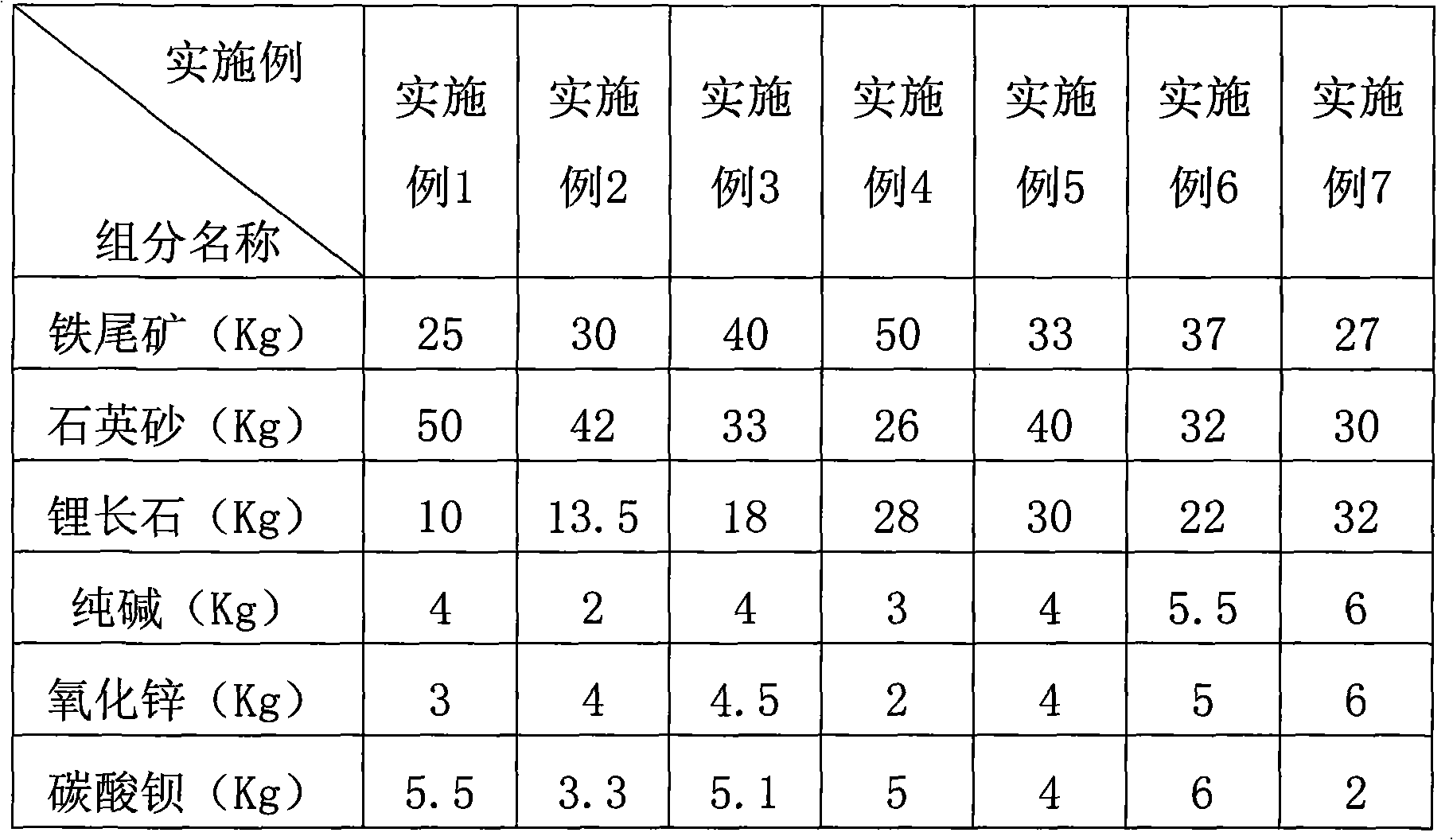Black glass ceramic and production method thereof
A glass-ceramic, black technology, applied in the field of black glass-ceramic, can solve the problems of single color of glass-ceramic and high production process cost, and achieve the effects of improving furnace efficiency, improving physical and chemical properties, and reducing energy consumption
- Summary
- Abstract
- Description
- Claims
- Application Information
AI Technical Summary
Problems solved by technology
Method used
Image
Examples
Embodiment 1
[0041] According to Table 2, each component described in Example 1 was weighed, wherein the quartz sand was vein quartz.
[0042] The preparation method comprises the following steps:
[0043] (1) Drying, sieving, and mixing the iron tailings in sequence to obtain dry powder iron tailings with a water content of 0.5% and a particle size of 40 mesh;
[0044] (2) dry powdered iron tailings are mixed with other components according to the stated ratio;
[0045] (3) Put the mixture obtained above in a box-type high-temperature electric furnace, and melt it at a temperature of 1500° C. for 1 hour to obtain molten glass with a viscosity of 10 Pa.s;
[0046] (4) The molten glass is flowed into water, and the water is quenched to become glass pellets;
[0047] (5) Put the glass pellets into the mold for nucleation and crystallization molding, nucleate at 655°C for 0.8 hours, then raise the temperature to 1020°C at a rate of 4.9°C / min, and crystallize and shape under the condition of...
Embodiment 2
[0049] According to Table 2, the components described in Example 2 were weighed, wherein the quartz sand included a mixture of 40% vein quartz and 60% quartzite.
[0050] The preparation method comprises the following steps:
[0051] (1) drying, sieving, and mixing the iron tailings successively to obtain dry powder iron tailings with a water content of 1% and a particle size of 80 mesh;
[0052] (2) dry powdered iron tailings are mixed with other components according to the stated ratio;
[0053] (3) Put the mixture obtained above in a box-type high-temperature electric furnace, and melt it at a temperature of 1510° C. for 2 hours to obtain molten glass with a viscosity of 10.5 Pa.s;
[0054] (4) The molten glass is flowed into water, and the water is quenched to become glass pellets;
[0055](5) Put the glass pellets into the mold for nucleation and crystallization molding, nucleate at 655°C for 1 hour, then raise the temperature to 1030°C at a rate of 4.9°C / min, and cryst...
Embodiment 3
[0057] According to Table 2, each component described in Example 3 was weighed, wherein the quartz sand was opal.
[0058] The preparation method comprises the following steps:
[0059] (1) drying, sieving, and mixing the iron tailings successively to obtain dry powder iron tailings with a water content of 3% and a particle size of 120 mesh;
[0060] (2) dry powdered iron tailings are mixed with other components according to the stated ratio;
[0061] (3) Put the mixture obtained above in a box-type high-temperature electric furnace and melt it at a temperature of 1480° C. for 2.5 hours to obtain molten glass with a viscosity of 11 Pa.s;
[0062] (4) The molten glass is flowed into water, and the water is quenched to become glass pellets;
[0063] (5) Put the glass pellets into the mold for nucleation and crystallization molding, nucleate at 655°C for 0.9 hours, then raise the temperature to 1050°C at a rate of 4.9°C / min, and crystallize and shape at a pressure of 25Pa , th...
PUM
| Property | Measurement | Unit |
|---|---|---|
| Granularity | aaaaa | aaaaa |
| Viscosity | aaaaa | aaaaa |
| Granularity | aaaaa | aaaaa |
Abstract
Description
Claims
Application Information
 Login to View More
Login to View More - R&D
- Intellectual Property
- Life Sciences
- Materials
- Tech Scout
- Unparalleled Data Quality
- Higher Quality Content
- 60% Fewer Hallucinations
Browse by: Latest US Patents, China's latest patents, Technical Efficacy Thesaurus, Application Domain, Technology Topic, Popular Technical Reports.
© 2025 PatSnap. All rights reserved.Legal|Privacy policy|Modern Slavery Act Transparency Statement|Sitemap|About US| Contact US: help@patsnap.com



